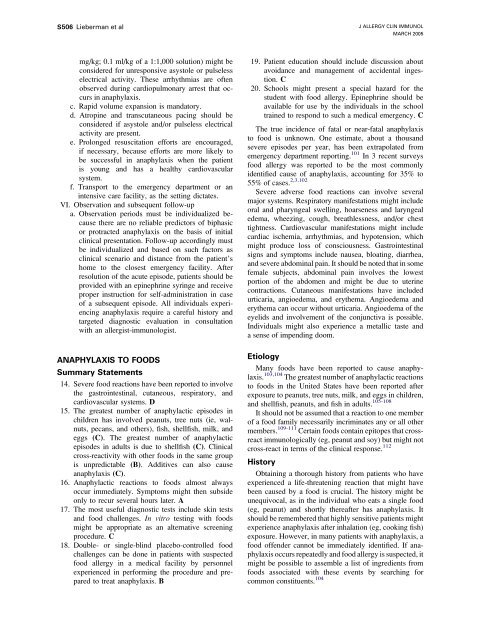Immunotherapy Safety for the Primary Care ... - U.S. Coast Guard
Immunotherapy Safety for the Primary Care ... - U.S. Coast Guard
Immunotherapy Safety for the Primary Care ... - U.S. Coast Guard
Create successful ePaper yourself
Turn your PDF publications into a flip-book with our unique Google optimized e-Paper software.
S506 Lieberman et al<br />
J ALLERGY CLIN IMMUNOL<br />
MARCH 2005<br />
mg/kg; 0.1 ml/kg of a 1:1,000 solution) might be<br />
considered <strong>for</strong> unresponsive asystole or pulseless<br />
electrical activity. These arrhythmias are often<br />
observed during cardiopulmonary arrest that occurs<br />
in anaphylaxis.<br />
c. Rapid volume expansion is mandatory.<br />
d. Atropine and transcutaneous pacing should be<br />
considered if asystole and/or pulseless electrical<br />
activity are present.<br />
e. Prolonged resuscitation ef<strong>for</strong>ts are encouraged,<br />
if necessary, because ef<strong>for</strong>ts are more likely to<br />
be successful in anaphylaxis when <strong>the</strong> patient<br />
is young and has a healthy cardiovascular<br />
system.<br />
f. Transport to <strong>the</strong> emergency department or an<br />
intensive care facility, as <strong>the</strong> setting dictates.<br />
VI. Observation and subsequent follow-up<br />
a. Observation periods must be individualized because<br />
<strong>the</strong>re are no reliable predictors of biphasic<br />
or protracted anaphylaxis on <strong>the</strong> basis of initial<br />
clinical presentation. Follow-up accordingly must<br />
be individualized and based on such factors as<br />
clinical scenario and distance from <strong>the</strong> patient’s<br />
home to <strong>the</strong> closest emergency facility. After<br />
resolution of <strong>the</strong> acute episode, patients should be<br />
provided with an epinephrine syringe and receive<br />
proper instruction <strong>for</strong> self-administration in case<br />
of a subsequent episode. All individuals experiencing<br />
anaphylaxis require a careful history and<br />
targeted diagnostic evaluation in consultation<br />
with an allergist-immunologist.<br />
ANAPHYLAXIS TO FOODS<br />
Summary Statements<br />
14. Severe food reactions have been reported to involve<br />
<strong>the</strong> gastrointestinal, cutaneous, respiratory, and<br />
cardiovascular systems. D<br />
15. The greatest number of anaphylactic episodes in<br />
children has involved peanuts, tree nuts (ie, walnuts,<br />
pecans, and o<strong>the</strong>rs), fish, shellfish, milk, and<br />
eggs (C). The greatest number of anaphylactic<br />
episodes in adults is due to shellfish (C). Clinical<br />
cross-reactivity with o<strong>the</strong>r foods in <strong>the</strong> same group<br />
is unpredictable (B). Additives can also cause<br />
anaphylaxis (C).<br />
16. Anaphylactic reactions to foods almost always<br />
occur immediately. Symptoms might <strong>the</strong>n subside<br />
only to recur several hours later. A<br />
17. The most useful diagnostic tests include skin tests<br />
and food challenges. In vitro testing with foods<br />
might be appropriate as an alternative screening<br />
procedure. C<br />
18. Double- or single-blind placebo-controlled food<br />
challenges can be done in patients with suspected<br />
food allergy in a medical facility by personnel<br />
experienced in per<strong>for</strong>ming <strong>the</strong> procedure and prepared<br />
to treat anaphylaxis. B<br />
19. Patient education should include discussion about<br />
avoidance and management of accidental ingestion.<br />
C<br />
20. Schools might present a special hazard <strong>for</strong> <strong>the</strong><br />
student with food allergy. Epinephrine should be<br />
available <strong>for</strong> use by <strong>the</strong> individuals in <strong>the</strong> school<br />
trained to respond to such a medical emergency. C<br />
The true incidence of fatal or near-fatal anaphylaxis<br />
to food is unknown. One estimate, about a thousand<br />
severe episodes per year, has been extrapolated from<br />
emergency department reporting. 101 In 3 recent surveys<br />
food allergy was reported to be <strong>the</strong> most commonly<br />
identified cause of anaphylaxis, accounting <strong>for</strong> 35% to<br />
55% of cases. 2,3,102<br />
Severe adverse food reactions can involve several<br />
major systems. Respiratory manifestations might include<br />
oral and pharyngeal swelling, hoarseness and laryngeal<br />
edema, wheezing, cough, breathlessness, and/or chest<br />
tightness. Cardiovascular manifestations might include<br />
cardiac ischemia, arrhythmias, and hypotension, which<br />
might produce loss of consciousness. Gastrointestinal<br />
signs and symptoms include nausea, bloating, diarrhea,<br />
and severe abdominal pain. It should be noted that in some<br />
female subjects, abdominal pain involves <strong>the</strong> lowest<br />
portion of <strong>the</strong> abdomen and might be due to uterine<br />
contractions. Cutaneous manifestations have included<br />
urticaria, angioedema, and ery<strong>the</strong>ma. Angioedema and<br />
ery<strong>the</strong>ma can occur without urticaria. Angioedema of <strong>the</strong><br />
eyelids and involvement of <strong>the</strong> conjunctiva is possible.<br />
Individuals might also experience a metallic taste and<br />
a sense of impending doom.<br />
Etiology<br />
Many foods have been reported to cause anaphylaxis.<br />
103,104 The greatest number of anaphylactic reactions<br />
to foods in <strong>the</strong> United States have been reported after<br />
exposure to peanuts, tree nuts, milk, and eggs in children,<br />
and shellfish, peanuts, and fish in adults. 105-108<br />
It should not be assumed that a reaction to one member<br />
of a food family necessarily incriminates any or all o<strong>the</strong>r<br />
members. 109-111 Certain foods contain epitopes that crossreact<br />
immunologically (eg, peanut and soy) but might not<br />
cross-react in terms of <strong>the</strong> clinical response. 112<br />
History<br />
Obtaining a thorough history from patients who have<br />
experienced a life-threatening reaction that might have<br />
been caused by a food is crucial. The history might be<br />
unequivocal, as in <strong>the</strong> individual who eats a single food<br />
(eg, peanut) and shortly <strong>the</strong>reafter has anaphylaxis. It<br />
should be remembered that highly sensitive patients might<br />
experience anaphylaxis after inhalation (eg, cooking fish)<br />
exposure. However, in many patients with anaphylaxis, a<br />
food offender cannot be immediately identified. If anaphylaxis<br />
occurs repeatedly and food allergy is suspected, it<br />
might be possible to assemble a list of ingredients from<br />
foods associated with <strong>the</strong>se events by searching <strong>for</strong><br />
common constituents. 104
















